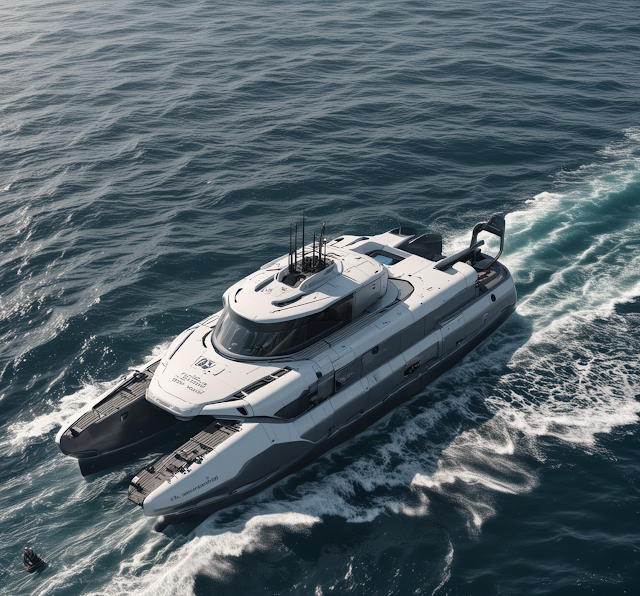The vast expanse of the world's oceans has long been the domain of skilled mariners, their ships guided by the steady hands and keen eyes of experienced crews. However, a transformative shift is underway, one that promises to revolutionize the way we think about maritime transportation. The future of autonomous ships is here, and it's poised to reshape the industry in profound ways.
As
we gaze into the crystal ball of maritime innovation, the emergence of
self-navigating vessels stands out as a game-changing development. These
autonomous ships, equipped with advanced sensors, artificial intelligence (AI),
and sophisticated navigation systems, are set to navigate the high seas without
the need for traditional human crews. This technological leap forward has the
potential to enhance efficiency, safety, and environmental sustainability,
ushering in a new era of ocean-based transportation.
Several
factors are converging to propel the rise of autonomous ships. Chief among them
is the need for increased efficiency and cost-effectiveness in the shipping
industry. Manning traditional vessels with crews can be a significant expense,
and the industry is constantly seeking ways to streamline operations and
maximize profits. Autonomous ships offer a tantalizing solution, as they can
operate with minimal or even no human intervention, potentially reducing labor
costs and enhancing overall profitability.
In
addition, safety considerations have played a pivotal role in the push towards
autonomous shipping. Navigating the treacherous waters of the world's oceans is
a challenging and hazardous task, and human error has been a leading cause of
maritime incidents and accidents. Autonomous ships, with their advanced sensor
suites and decision-making algorithms, have the potential to eliminate many of
the risks associated with human-operated vessels, potentially saving lives and
reducing the environmental impact of accidents.
Furthermore,
the growing emphasis on environmental sustainability has also fueled the
development of autonomous ships. Traditional cargo vessels, with their heavy
reliance on fossil fuels, have long been a source of concern for
environmentalists. Autonomous ships, with their ability to optimize routes and
energy usage, can contribute to a reduction in greenhouse gas emissions and
other pollutants, aligning with the global push for greener transportation
solutions.
The Technology Behind Autonomous Ships
The
heart of autonomous ship technology lies in the integration of various
cutting-edge systems and sensors. At the core of these vessels are
sophisticated navigation and control systems, powered by AI and machine
learning algorithms. These systems are capable of processing vast amounts of
data from an array of sensors, including radar, LiDAR, GPS, and cameras, to
continuously monitor the ship's surroundings and make real-time decisions about
navigation and control.
The
decision-making capabilities of autonomous ships are equally impressive.
Sophisticated AI algorithms, trained on vast datasets and real-world scenarios,
enable the vessels to navigate complex situations, avoid collisions, and make
informed decisions about optimizing their routes and operations. These systems
can also adapt to changing conditions, such as weather patterns and traffic
congestion, ensuring a more reliable and efficient journey.
In
addition to navigation and control, autonomous ships are also equipped with
advanced systems for monitoring and managing onboard systems, such as
propulsion, power generation, and cargo handling. These integrated systems
allow the vessels to operate with minimal human intervention, further reducing
the need for traditional crews and enhancing overall operational efficiency.
Potential Benefits and Challenges
The
emergence of autonomous ships presents a multitude of potential benefits, both
for the shipping industry and society at large. One of the most significant advantages
is the potential for increased efficiency and cost savings. By eliminating the
need for large crews, autonomous ships can reduce labor costs and improve
profitability for shipping companies. Additionally, the ability to optimize
routes and energy usage can lead to significant fuel savings and reduced
environmental impact.
Furthermore,
autonomous ships have the potential to enhance safety by minimizing the risk of
human error and reducing the exposure of crews to the hazards of the open sea.
With their advanced sensor suites and decision-making capabilities, these
vessels can navigate treacherous waters more safely, potentially reducing the
occurrence of accidents and environmental disasters.
However, the transition to autonomous shipping is not without its challenges. One of the primary concerns is the potential impact on maritime employment, as the need for traditional seafaring crews may diminish. This shift could have significant social and economic implications, and addressing the concerns of affected workers will be a crucial aspect of the transition.
Another
challenge lies in the regulatory and legal framework surrounding autonomous
ships. As this technology is still relatively new, existing maritime laws and
regulations may need to be updated to accommodate the presence of
self-navigating vessels. Ensuring the safe and responsible operation of these
ships, while addressing liability and insurance concerns, will be a key focus
for policymakers and industry stakeholders.
Additionally,
the cybersecurity of autonomous ships is a crucial consideration. These
vessels, with their advanced digital systems and connectivity, may be
vulnerable to cyber threats, such as hacking, data breaches, and system
disruptions. Robust cybersecurity measures will be essential to protect these
autonomous vessels and the critical infrastructure they support.
The Road Ahead
As
the future of autonomous ships unfolds, we can expect to see a gradual but
steady transformation of the maritime industry. Initial deployments of these
vessels are likely to focus on specific applications, such as short-sea
shipping, port operations, and coastal surveillance, where the benefits of
autonomy can be most readily realized.
Over
time, as the technology matures and regulatory frameworks are established, the
scope of autonomous ship operations is likely to expand, with the potential for
long-haul, transoceanic voyages without human crews. This transition will not
happen overnight, but rather through a phased approach that balances innovation,
safety, and the needs of the broader maritime ecosystem.





Comments
Post a Comment